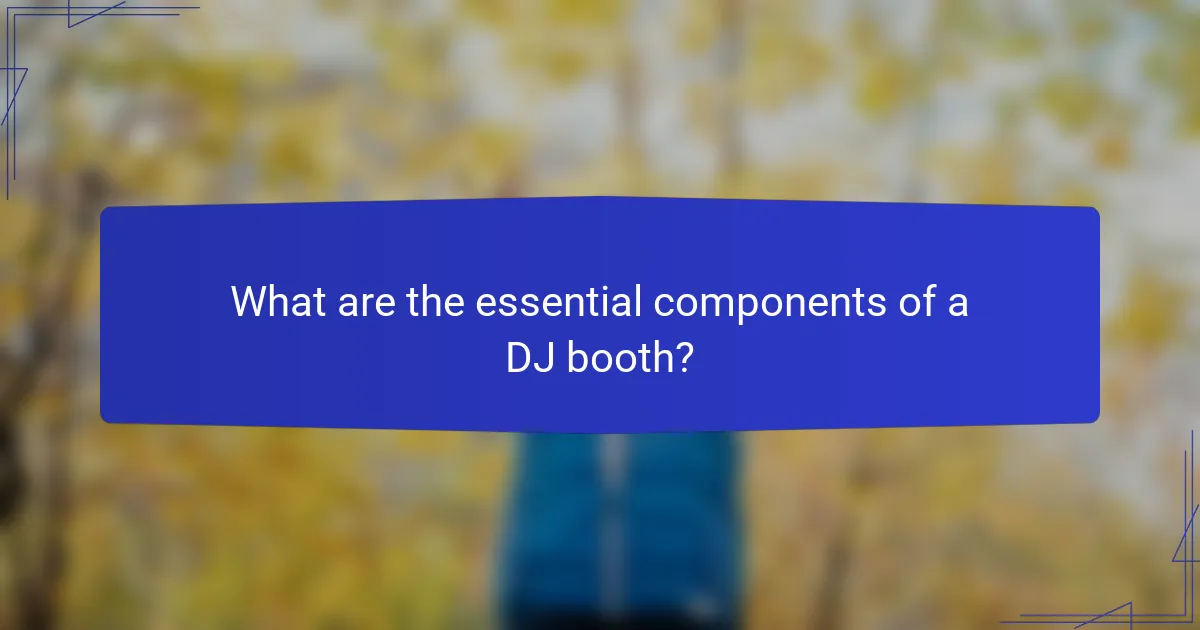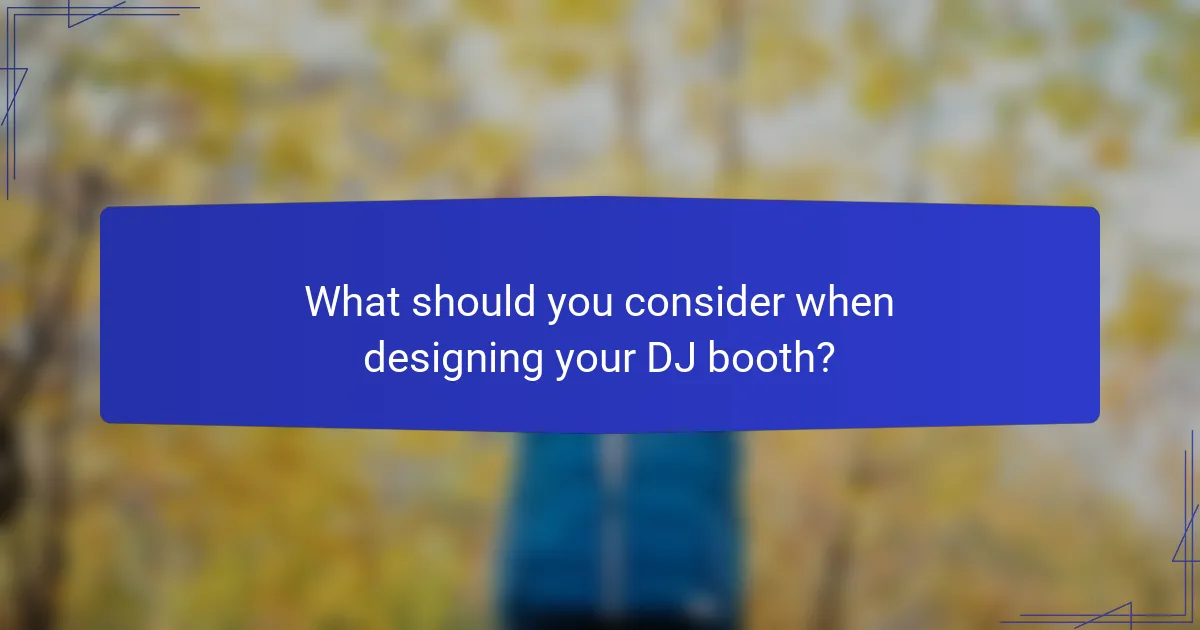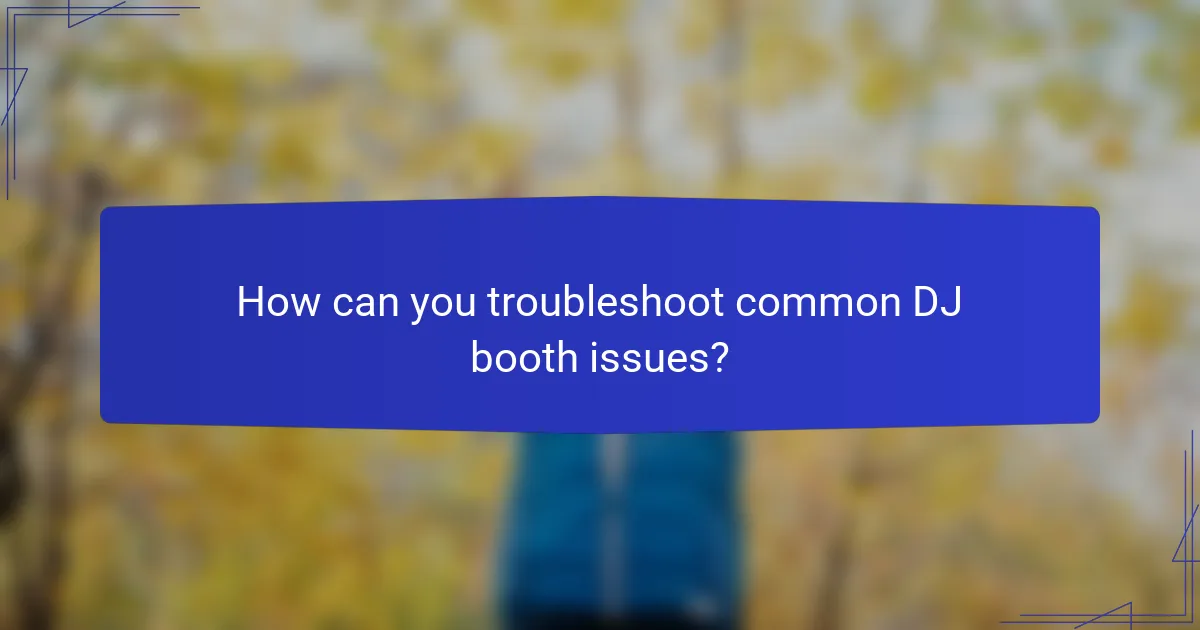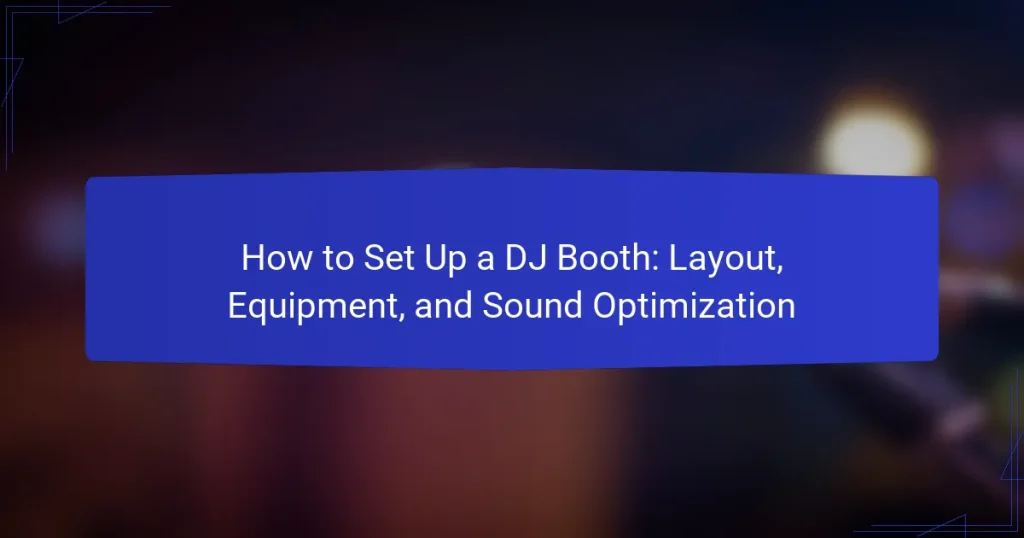A DJ booth is a critical setup for live music performances, typically consisting of a mixer, turntables or CDJs, speakers, and a laptop. This article outlines essential aspects of designing an effective DJ booth, including layout considerations for accessibility and audience interaction, equipment selection for optimal performance quality, and sound optimization techniques such as speaker placement and acoustics. Additionally, it provides troubleshooting tips for common issues encountered in DJ setups, such as checking connections, power supply, and audio sources. By understanding these components and strategies, DJs can enhance their performance and create an engaging experience for their audience.

What are the essential components of a DJ booth?
A DJ booth typically includes a mixer, turntables or CDJs, speakers, and a laptop. The mixer allows the DJ to blend tracks and control sound levels. Turntables or CDJs are used for playing vinyl records or digital music. Speakers amplify the sound for the audience. A laptop is often utilized for music library management and software control. Additional components may include headphones for monitoring, audio interfaces for sound quality, and lighting equipment for visual effects. Each component plays a crucial role in delivering a seamless performance.
How do different layouts impact DJ performance?
Different layouts significantly impact DJ performance by affecting accessibility, visibility, and interaction with the audience. A layout that allows easy access to equipment enhances a DJ’s ability to mix tracks seamlessly. Visibility is crucial; a well-structured booth layout ensures the DJ can see and engage with the crowd.
Layouts that promote audience interaction can create a more dynamic atmosphere. For example, a central booth layout often encourages more crowd engagement compared to a side booth. Research indicates that booth positioning influences audience energy levels, affecting overall performance.
Moreover, the arrangement of equipment impacts workflow efficiency. A logical layout minimizes movement and maximizes performance time. Studies show that DJs performing in optimized layouts report higher satisfaction and better audience response.
What are the common layout types for a DJ booth?
The common layout types for a DJ booth include the straight layout, L-shaped layout, and circular layout. The straight layout features a linear arrangement of equipment. This layout maximizes space efficiency and is often used in smaller venues. The L-shaped layout allows for more equipment and can create a more interactive experience for the DJ. This type is suitable for larger setups and provides better visibility. The circular layout promotes a 360-degree interaction with the audience. It is often used in festivals and large events to engage more attendees. Each layout type serves specific venue needs and enhances DJ performance.
How can layout influence crowd interaction?
Layout significantly influences crowd interaction by determining the flow of movement and engagement. An open layout encourages free movement among attendees. This design facilitates socializing and dancing, enhancing the overall experience. In contrast, a cramped layout can restrict movement and create frustration. Research indicates that crowd density impacts interaction levels; a study by Helbing et al. (2007) found that optimal spacing promotes positive social behavior. Additionally, strategic placement of the DJ booth can draw attention and foster connection between the DJ and audience. A well-considered layout ultimately shapes the atmosphere and energy of the event.
What equipment is necessary for a DJ booth?
A DJ booth requires several essential pieces of equipment. The primary components include a DJ mixer, turntables or CDJs, and speakers. A DJ mixer allows for sound control and blending of tracks. Turntables or CDJs serve as playback devices for vinyl or digital music. Speakers are necessary for amplifying sound to the audience. Additionally, headphones are important for cueing tracks before mixing. A laptop or USB drive is often used for music storage and playback. Cables and audio interfaces may also be needed for connectivity. Proper lighting and a stable booth structure enhance the overall setup.
Which types of mixers are best for DJs?
The best types of mixers for DJs include club mixers, battle mixers, and digital mixers. Club mixers are designed for live performances and feature multiple channels. They often include effects and EQ controls. Battle mixers are tailored for turntablism and scratching. They typically have a smaller footprint and robust crossfaders. Digital mixers integrate with software and offer advanced features like MIDI control. Each mixer type serves specific DJing styles and environments. These distinctions help DJs choose equipment that fits their performance needs.
What role do speakers and monitors play in a DJ setup?
Speakers and monitors are essential components in a DJ setup. Speakers project sound to the audience, creating an immersive experience. They amplify the music, ensuring it reaches listeners at an appropriate volume. Monitors, on the other hand, provide the DJ with real-time audio feedback. This allows DJs to hear their mixes accurately while performing. Accurate sound reproduction is crucial for mixing and beatmatching. High-quality speakers and monitors enhance sound clarity and fidelity. This ensures that the DJ can deliver a polished performance. Proper placement of these audio devices optimizes sound distribution in the venue.
How can sound optimization enhance the DJ experience?
Sound optimization significantly enhances the DJ experience by improving audio clarity and balance. It allows DJs to create a more immersive atmosphere for the audience. Proper sound optimization involves adjusting equalization, volume levels, and speaker placement. This ensures that all frequencies are heard clearly, preventing distortion. Research indicates that optimized sound systems can increase audience engagement by up to 30%. Additionally, sound optimization helps in reducing feedback and other unwanted noise. This leads to a smoother performance and better overall sound quality. Therefore, sound optimization is crucial for delivering an exceptional DJ experience.
What techniques can be used for soundproofing a DJ booth?
To soundproof a DJ booth, various techniques can be employed. Acoustic panels can be installed to absorb sound waves. These panels reduce echo and improve sound quality. Bass traps can be placed in corners to manage low-frequency sounds. Soundproof curtains can be used to cover windows and absorb external noise. Sealing gaps and cracks with weather stripping prevents sound leakage. Adding a heavy door enhances sound isolation. Floating floors can minimize vibrations from the booth. Each technique contributes to a more controlled acoustic environment, essential for optimal DJ performance.
How does speaker placement affect sound quality?
Speaker placement significantly affects sound quality by influencing the soundstage and frequency response. Proper positioning allows for optimal sound dispersion and minimizes phase cancellation. Speakers placed too close to walls can create bass buildup, while those too far may result in weak low frequencies. The ideal placement is often at ear level and angled towards the listener. Research indicates that a triangle formation between speakers and the listener enhances stereo imaging. This placement strategy improves clarity and balance, resulting in a more immersive listening experience.

What should you consider when designing your DJ booth?
When designing your DJ booth, consider the layout, equipment, and sound optimization. The layout should facilitate easy access to all equipment. Ensure there is enough space for movement and interaction with the audience. Equipment selection is crucial for performance quality. Choose reliable mixers, turntables, and speakers that meet your needs. Sound optimization involves acoustics and speaker placement. Proper speaker positioning enhances sound quality. Additionally, consider the booth’s aesthetic appeal. A visually appealing booth can enhance the overall experience.
How does venue size influence your booth setup?
Venue size significantly influences booth setup by determining space allocation and equipment arrangement. In larger venues, DJs can utilize more extensive setups with additional equipment. This allows for a more elaborate display and sound system. Conversely, smaller venues require compact setups to maximize available space. DJs may need to prioritize essential equipment in these situations. Additionally, venue size affects audience interaction. In larger spaces, DJs can create more distance from the crowd, while smaller venues promote closer engagement. The layout must accommodate the unique acoustics of each venue size. Proper sound optimization is crucial to ensure clarity and volume in varying spaces.
What are the best practices for setting up in small venues?
The best practices for setting up in small venues include optimizing space, ensuring sound quality, and arranging equipment effectively. First, assess the layout to maximize available space. Position the DJ booth in a corner or against a wall to create more room for movement. Second, use compact equipment that fits the venue’s size without compromising functionality. Third, ensure proper sound distribution by placing speakers at ear level and avoiding corners where bass can accumulate. Fourth, consider lighting that enhances the atmosphere without overwhelming the space. Lastly, test the setup before the event to make necessary adjustments. These practices ensure an effective and enjoyable experience for both the DJ and the audience.
How can you adapt your booth for large events?
To adapt your booth for large events, increase the booth size to accommodate more equipment and space. Use modular designs that can be expanded or reconfigured easily. Ensure visibility by raising the booth or using elevated platforms. Incorporate high-quality sound equipment to fill larger spaces effectively. Use visual elements like LED screens to attract attention from afar. Optimize the layout for better traffic flow, allowing guests to approach from multiple angles. Provide seating or standing areas for attendees to engage comfortably. Ensure power supply and cable management can support additional equipment without clutter.
What are the safety considerations for a DJ booth?
Safety considerations for a DJ booth include proper electrical setup, stable equipment placement, and crowd management. Electrical equipment must be grounded to prevent shocks. Cables should be secured to avoid tripping hazards. The booth should be positioned away from the crowd to minimize interference. Adequate ventilation is necessary to prevent overheating of equipment. Emergency exits must be accessible in case of emergencies. Noise levels should be monitored to protect hearing. Regular inspections of equipment can prevent malfunctions. These measures ensure a safe environment for both the DJ and the audience.
How can you ensure electrical safety in your setup?
To ensure electrical safety in your setup, use high-quality equipment and proper wiring. Inspect all cables for damage before use. Avoid overloading outlets to prevent overheating. Use surge protectors to guard against power spikes. Maintain a dry environment to reduce the risk of electrical shock. Keep electrical connections away from water sources. Follow manufacturer guidelines for equipment installation and usage. Regularly check for any signs of wear or malfunction in your electrical components. These practices help minimize risks associated with electrical hazards.
What measures should be taken to protect equipment?
To protect equipment, implement proper storage and handling practices. Use padded cases to shield gear from physical damage. Ensure the booth is clean and dry to prevent moisture-related issues. Utilize surge protectors to safeguard against electrical surges. Regularly inspect cables and connections for wear and tear. Maintain a stable temperature to avoid overheating components. Additionally, secure equipment during transport to minimize movement. These measures collectively enhance the longevity and functionality of DJ equipment.

How can you troubleshoot common DJ booth issues?
To troubleshoot common DJ booth issues, start by checking all connections. Ensure that cables are securely plugged into the mixer, speakers, and power sources. Next, inspect the power supply to confirm that all equipment is receiving electricity. If there are sound issues, adjust the volume levels on both the mixer and speakers. Additionally, test different audio sources to identify if the problem lies with a specific device. For software-related issues, restart the DJ software and check for updates. If feedback occurs, reposition microphones and speakers to reduce interference. Lastly, consult the user manuals for specific troubleshooting tips related to your equipment. These steps address the most frequent problems encountered in DJ booths.
What are the most frequent technical problems faced by DJs?
DJs frequently face technical problems such as equipment failure, sound quality issues, and connectivity problems. Equipment failure can include malfunctioning mixers, turntables, or speakers. Sound quality issues often arise from poor acoustics or incorrect settings. Connectivity problems may involve cables, adapters, or wireless connections that fail during a performance. Additionally, power supply issues can disrupt the entire setup. These challenges can hinder a DJ’s performance and impact the overall experience for the audience.
How do you resolve sound distortion issues?
To resolve sound distortion issues, first check the audio equipment connections. Ensure all cables are securely plugged in and not damaged. Next, adjust the equalizer settings to eliminate frequencies causing distortion. Reducing bass or treble may help clarify sound. Additionally, inspect the speakers for any obstructions or damage. Placing speakers at an appropriate height and distance can also minimize distortion. Finally, consider using soundproofing materials in the DJ booth to absorb unwanted noise. These steps have been effective in various sound optimization scenarios, as confirmed by audio engineering best practices.
What steps can you take if equipment fails during a performance?
If equipment fails during a performance, first, remain calm and assess the situation. Identify which piece of equipment is malfunctioning. Check all connections and power sources to ensure everything is properly plugged in. If the issue persists, switch to backup equipment if available. Communicate with the audience to keep them informed. Use a simple playlist or pre-recorded set to maintain the flow of the performance. Troubleshoot the issue quickly, focusing on the most critical equipment first. Having a plan for equipment failure can minimize disruption during the show.
What tips can help optimize your DJ booth setup?
To optimize your DJ booth setup, ensure proper equipment placement for accessibility and efficiency. Position your turntables and mixer within easy reach to facilitate seamless transitions. Use high-quality cables to minimize signal loss and maintain sound clarity. Arrange monitors at ear level to ensure accurate sound feedback. Maintain a clutter-free space to enhance workflow and prevent distractions. Incorporate adequate lighting to enhance visibility and create the desired atmosphere. Regularly check and maintain your equipment to ensure optimal performance. These practices contribute to a professional and effective DJ setup.
How can you improve your workflow at the booth?
To improve your workflow at the booth, organize your equipment for easy access. Position frequently used items within reach to minimize movement. Use cable management solutions to prevent tangling and clutter. Label all cables and devices to streamline setup and teardown. Establish a consistent layout for your gear to enhance familiarity. Practice your set before the event to identify any workflow issues. Utilize software tools for track organization to speed up song selection. Monitor your sound levels continuously to ensure optimal audio quality.
What are the best practices for maintaining your equipment?
Regular cleaning is essential for maintaining your equipment. Dust and debris can affect performance and longevity. Use a soft cloth to wipe surfaces and avoid harsh chemicals. Check connections and cables for wear and tear regularly. Replace damaged components immediately to prevent further issues. Store equipment in a dry, cool place when not in use. This helps prevent rust and corrosion. Follow manufacturer guidelines for specific maintenance tasks. Keeping a maintenance log can also be beneficial for tracking service intervals.
The main entity of the article is the DJ booth, which encompasses essential components such as mixers, turntables, speakers, and laptops. The article provides a comprehensive overview of how to effectively set up a DJ booth, discussing various layouts and their impact on performance and crowd interaction. It details the necessary equipment, including different types of mixers and the role of speakers and monitors, while emphasizing the importance of sound optimization and troubleshooting common issues. Key considerations for designing the booth, adapting to venue sizes, and maintaining equipment are also covered, ensuring DJs can deliver high-quality performances.

